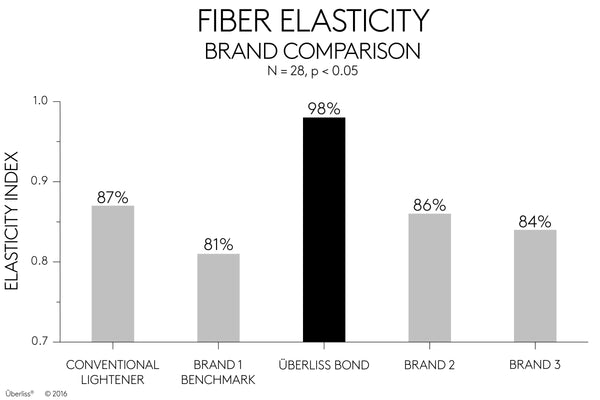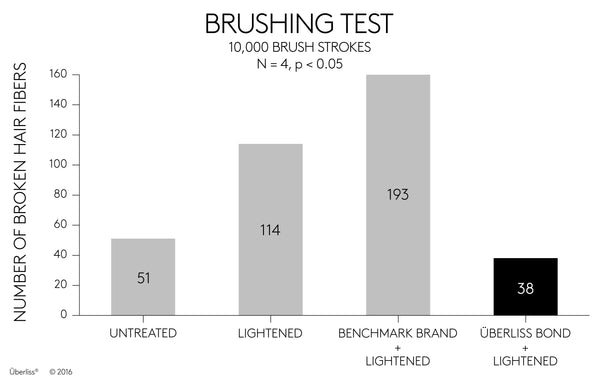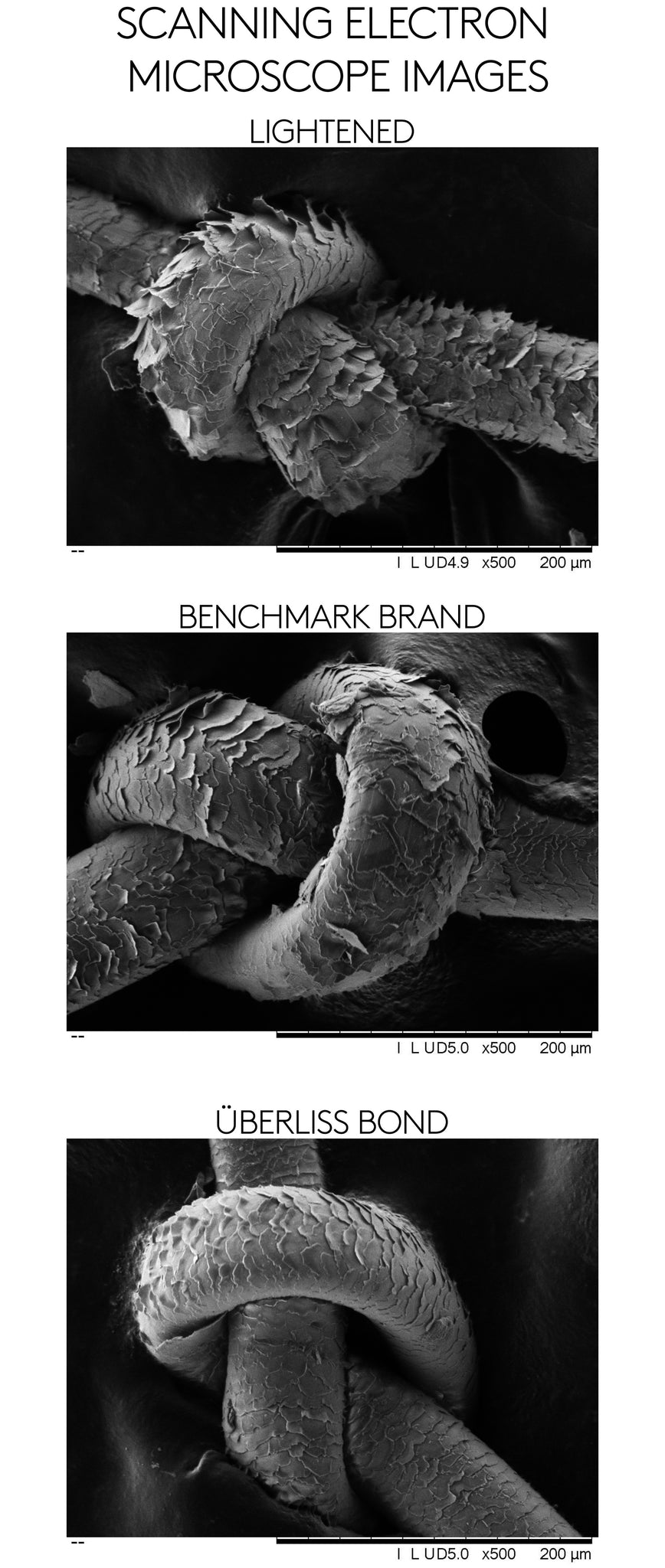A look into the science behind the Uberliss Bond Treatment
Coryn MarzejonShare
At Überliss we take pride in discovering how and why things work the way they do. A few weeks ago we officially launched the Überliss Bond Treatment and we know you are all wondering, "What makes it stand out from competitors?"
Our award winning R&D team has perfected the Überliss Bond Treatment to sustain 98% of the hair's elasticity post coloring and lightening. Our claims are backed up by rigorous scientific testing of our own system as well as of other bond treatments in the market. None of their results even come close to matching ours.
But before we sit here and tell you that our Bond Treatment is better than the rest, we want to show you HOW and WHY it’s better, and discuss the science behind it all. Let us first start with some chemistry lessons. We talked to Überliss' Principal Scientist, Dr. Maliha Syed, to give us the breakdown of the bonds in our hair:
An Introduction to Bond Builders
The general structure of hair includes an outermost layer called the cuticle and an interior layer called the cortex. The hair is composed of different proteins, the most abundant one being keratin. These hair proteins contain an amino acid called cysteine. Cysteine contains sulfur-hydrogen (S-H or sulfhydryl bonds). When oxidized, the S-H bonds in cysteine react with each other creating disulfide or S-S crosslinks, which are stronger than the S-H bonds. These disulfide bonds are formed by our bodies before the hair emerges from the follicle. You may be wondering why S-S crosslinks are so important to hair. Disulfide crosslinks majorly contribute to your hair's high strength and elasticity and also lock in your hair's unique shape.
During the coloring and lightening process the hair's naturally occurring S-S crosslinks are broken. When lightener is applied to the hair, hydrogen peroxide (which is the primary ingredient in bleach) strips the melanin and breaks the S-S crosslinks, creating not only weaker S-H bonds but also other types of bonds such as cysteic acid (SO3H) bonds.
The unique formula of the Uberliss Bond Treatment is designed to repair and/or prevent crosslinks from breaking during the coloring and lightening process. We have chosen a unique active molecule, which is the primary component of the Bond Regenerator, to create or regenerate crosslinks in the both cuticle and cortex of the hair fiber.

What are the general measurements for good hair?
Our avant-garde laboratory is continually testing the efficacy of our products, mainly to determine how to make your hair as healthy as possible. Below we have described a few of the general hallmarks of healthy hair along with an explanation of the testing we use. The lab results for the Uberliss Bond Treatment as well as our competitors' bond systems are also revealed. Keep reading to see the results!
High Elasticity Index: Hair fibers are naturally elastic, which means they can stretch but can also go back to their original shape after being pulled, twisted, combed, styled etc. Thus, elasticity is a very good measure of what's going on inside the hair. What’s more is that hair's ability to be elastic is directly related to the presence of crosslinks. Therefore, our elasticity test is a great measure of the amount of crosslinks in the hair fiber. A single hair fiber's elasticity is reported as an index, called "the elasticity index", which is a measure of the change in your hair's strength before and after chemical treatment. An example of the elasticity results for conventional lightener, the Uberliss Bond System, and three other competing brands is shown in the “Fiber Elasticity” graph below. An elasticity value of 1.00 or 100% would indicate no loss in elasticity, representing a healthy hair fiber.

As can be seen by the “Fiber Elasticity” graph above, after lightening the hair with 40 volume developer and conventional lightener the hair's elasticity dropped to 87%, indicating that 13% of the hair's original elasticity was lost due to destruction of S-S bonds. By using the Uberliss Bond Treatment however, 98% of the hair's original elasticity was preserved. The competing bond treatments did not improve the elasticity at all and the Überliss Bond system even outperformed the benchmark brand.
Fiber Breakage: While elasticity demonstrates the ability of our hair to endure everyday strenuous activities such as brushing and styling, some hair fibers are too weak and simply break upon stretching. Thus we also have custom-made experiments that simulate these day-to-day activities that cause hair breakage. One example is our brushing test, which measures the number of hair fibers broken during continuous and repetitive brushing, e.g. during 10,000 brush strokes.
The average number of broken hair fibers is shown in the “Brushing Test” graph below for four different treatments:

The fiber brushing test revealed that after 10,000 brush strokes, our control group (untreated hair) had 51 broken hair fibers, conventionally lightened hair displayed 114 broken hair fibers, the benchmark brand treatment resulted in 193 broken fibers, whereas hair treated with the Uberliss Bond Treatment only had 38 broken hair fibers. This evidence suggests that hair treated with the Überliss Bond Treatment had the fewest amount of broken hair fibers and is 3X less prone to breakage when compared to conventional lightener.
Porosity Test: When you chemically treat (color, lighten, etc.) your hair, chips, cracks, and pores are created on the hair surface, all of which serve as an entry way for outside elements to permeate into the hair fiber. Thus, these additional pores cause the hair to be more absorbent to substances like water for example. Frizz is a common problem with highly porous hair because the hair shaft has more openings available for humidity to enter and swell the hair. Having highly porous hair may also affect color retention—dyes may penetrate into the cortex faster but color will wash out faster too. All in all, high porosity hair is more susceptible to mechanical and chemical damage as well as breakage since the cortex of the hair is less protected.
We test the porosity of the hair by measuring the liquid retention of hair fibers through a weight test. This test aims to quantify the amount of liquid the hair can hold during various levels of damage. When the hair is very healthy, liquid goes in slower resulting in a lower % liquid retention as compared to damaged hair in which it is easier for liquid to enter the hair shaft.

The “Porosity Test” graph above shows that the porosity of hair treated with the Uberliss Bond Treatment is significantly less than the porosity of conventionally lightened hair. Hair treated with conventional lightener was therefore more damaged, showing 27.4% porosity, as compared to hair treated with the Bond Regenerator, which displayed 26.8% porosity.
Surface Imaging: At Überliss we utilize a Scanning Electron Microscope (SEM) to analyze the surface damage incurred to the hair fiber as a result of chemical treatment. As can be seen from the “SEM Images” below, conventional lightener leaves the cuticles lifted considerably. The benchmark brand displayed cuticle chipping and a rough surface. The Uberliss Bond Treatment yields an ideal surface image of the hair fiber—little to no cuticle chipping as well as smooth and flat cuticle layers.

We have put a lot of effort into creating the best bond treatment possible for stylists to achieve great coloring and lightening results for their clients.
We will continue to roll out science based material in the weeks to come. We think it's important to show you the data and facts behind our Überliss Bond Treatment. If you have any questions or are interested in learning more please leave comments below!

42 comments
I use Olaplex in my salon at the moment but I would be interested in learning more about this product please!
I am very interested in using your product.. I would like more info on the application.. and pricing for the service.
Would love tolerant more about this product email info please
Will it help hair that is in poor health already or is it just to prevent poor health from happening?
Would like to try this product, do you offer free samples or discounts, seeing is believing.